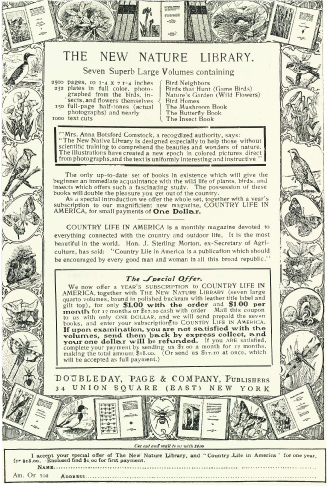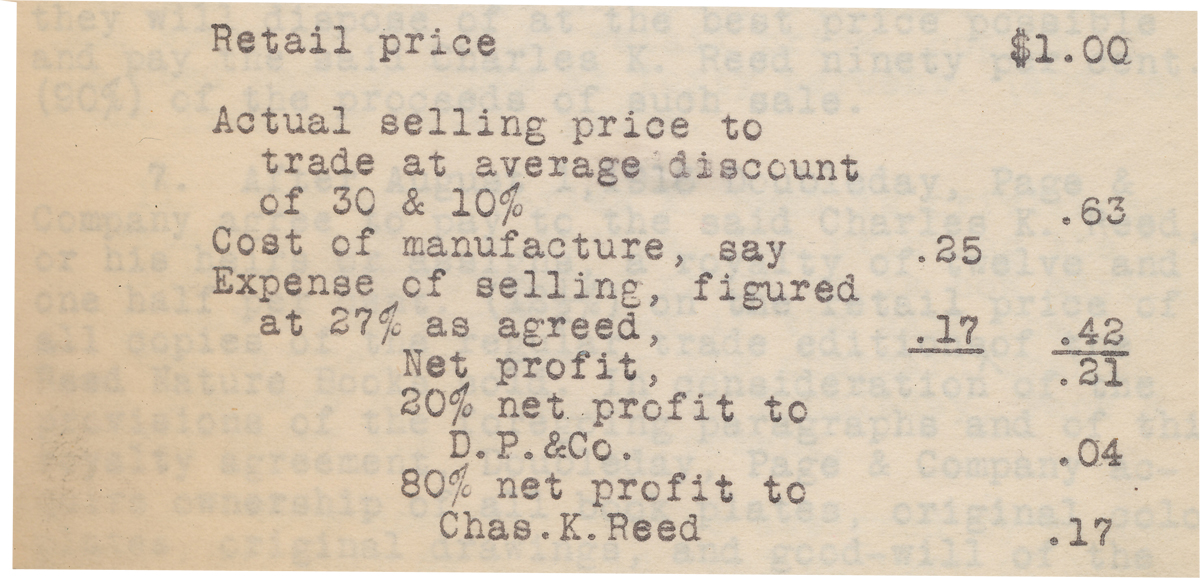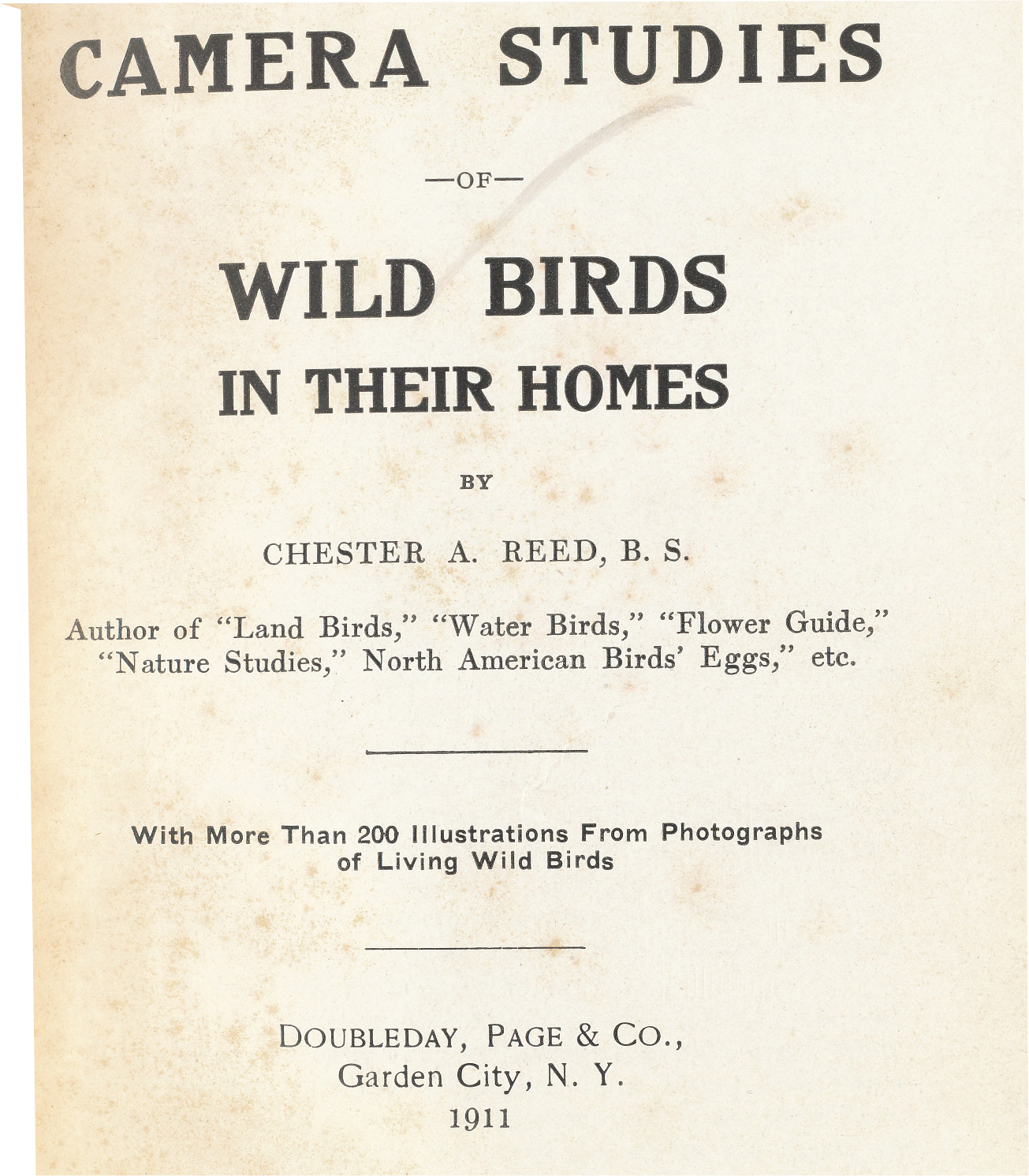Question 2:


What is the relationship between Charles K. Reed and Doubleday, Page & Company?
Context
Doubleday, Page & Company played an important role in the publication of books edited by Charles K. Reed. Between 1901 and 1915 inclusively, Charles K. Reed published 33 books. In all of those books, only 4 books were officially edited for the first time by D. P. & C. “Doubleday, Page & Company”.
How did the business relationship evolve and why?
To better understand Doubleday, Page & Company’s interest in the collection of books, here is the comprehensive list of all the books edited by Charles, including the dates of the copyright registrations.
List of books edited by Charles K. Reed
1901, 1902, 1903, 1904, 1905
American Ornithology For the Home and School
Author: Chester A. Reed, Editor: Chas K. Reed, Copyright : Chas K. Reed
1903
Color Key to North American Birds, August 31 (1)
Author: F. M. Chapman, Chester A. Reed, Editor : Doubleday, Page & CO, Copyright : Doubleday, Page & CO
Guide to Taxidermy, Dec. 30 (2)
Author: Chas K. Reed, Editor : Chas K. Reed, Copyright : Chas K. Reed
1904
North American Birds Eggs, Apr. 9 (3)
Author: Chester A. Reed, Editor: Doubleday, Page & CO, Copyright: Chester A. Reed
1905
Bird Guide Part 2, Land Birds East of the Rockies, August 26
Author: Chester A. Reed, Editor: Chas K. Reed, Copyright: Chas K. Reed
1906
Bird Guide Part 1, Water birds, Game birds, Apr. 25
Author: Chester A. Reed, Editor: Chas K. Reed, Copyright: Chas K. Reed
1907
Flower Guide, Wild Flowers East of the Rockies. Jan. 28
Author: Chester A. Reed, Editor: Chas K. Reed, Copyright: Chas K. Reed
1908
Guide to Taxidermy, revised, June 10
Author: Chas K. And Chester A. Reed, Editor: Chas K. Reed, Copyright: Chas K. Reed
Goldfish, Aquaria and Ferneries, Oct. 9
Author: Chester A. Reed, Editor: Chas K. Reed, Copyright: Chas K. Reed
1909
Bird Guide Part 2, Land Birds revised, Apr. 27
Author: Chester A. Reed, Editor: Chas K. Reed, Copyright: Chas K. Reed
Guide to the Mushrooms, August 26 (4)
Author: Emma Taylor Cole, Editor: Chas K. Reed, Copyright: Chas K. Reed
1910
Wild Flowers East of the Rockies ( Oil color painting), August 10
Author: Chester A. Reed, Editor: Chas K. Reed, Copyright: Chas K. Reed
Flower Guide Revised ( Oil color painting), Sept. 22
Author: Chester A. Reed, Editor: Chas K. Reed, Copyright: Chas K. Reed
Bird Guide Part 1, Water Birds ( Oil color painting), October 10
Author: Chester A. Reed, Editor: Chas K. Reed, Copyright: Chas K. Reed
1911
Guide to the Birds of New Jersey (5)
Author: Chester A. Reed, Beechers S. Bowdish, Editor: Chas K. Reed, Copyright: Chas K. Reed
Nature Studies “Birds”, June 1
Author: Chester A. Reed, Editor: Chas K. Reed, Copyright: Chas K. Reed
Camera Studies of Wild Birds in their Homes, July 1
Author: Chester A. Reed, Editor: Chas K. Reed, Copyright: Chas K. Reed
Nature Studies “In Field & Wood”, July 15
Author: Chester A. Reed, Editor: Chas K. Reed, Copyright: Chas K. Reed
1912
Wild Birds of New York, May 30 (6)
Author: Chester A. Reed, Editor: Mohonk Salesroom, Copyright: Chas K. Reed
Wild Birds of New England, May 30
Author: Chester A. Reed, Editor: Chas K. Reed, Copyright: Chas K. Reed
Wild Flowers of New York, July 1 (6)
Author: Chester A. Reed, Editor: Mohonk Salesroom, Copyright: Chas K. Reed
Wild Flowers of New England, July 1
Author: Chester A. Reed, Editor: Chas K. Reed, Copyright: Chas K. Reed
Wild Birds of Mohonk Catskills Adirondack, May 30 (6)
Author: Chester A. Reed, Editor: Mohonk Salesroom, Copyright: Chas K. Reed
Wild Flowers of Mohonk Catskills Adirondacks, July 1 (6)
Author: Chester A. Reed, Editor: Mohonk Salesroom, Copyright: Chas K. Reed
Birds of Eastern North America, August 28
Author: Chester A. Reed, Editor: Doubleday, Page & CO, Copyright: Chas K. Reed, Chester A. Reed, Harry F. Harvey, R. I. Brasher
1913
American Game Birds, Jan. 1 (7)
Author: Chester A. Reed, Editor: Chas K. Reed, Copyright: Chas K. Reed
Illustrated Bird Dictionary and Note Book, Vol 1, Land Birds, Jan. 1 (8)
Author: Chester A. Reed, Editor: Chas K. Reed, Copyright: Chas K. Reed
Illustrated Bird Dictionary and Note Book, Vol 2, Water Birds, Jan 1 (8)
Author: Chester A. Reed, Editor: Chas K. Reed, Copyright: Chas K. Reed
Western Bird Guide, June 1 (9)
Author: Chester A. Reed, Harry F. Harvey, R. I. Brasher, Editor: Chas K. Reed, Copyright: Chas K. Reed
1914
The Bird Book, December 12, 1914 (10)
Author: Chester A. Reed, Editor: Chas K. Reed, Copyright: Chas K. Reed
1915
Animal Guide, May 1 (11)
Author: Chas K. Reed, Editor: Chas K. Reed, Copyright: Chas K. Reed
Comments:
1 : All publication rights were sold to Mr. Frank M. Chapman in June 1912.
2 : Charles K. Reed’s first book as the author.
3 : Only book with copyrights to Chester A. Reed.
4 : The copyrights were sold to Emma Taylor Cole in 1922 by Carrie B. Reed.
5 : The copyrights were never registered. Carrie B. Reed was not able to transfer the copyrights in 1922 after Charles K. Reed’s death.
6 : Two similar books with identical content were published by Mohonk Salesroom.
• Wild Birds of Mohonk Catskills Adirondacks, author Chester A. Reed
• Wild Flowers of Mohonk Catskills Adirondacks, author Chester A. Reed
They were probably partners in the same copyright as Wild Birds of New York and Wild Flowers of New York.
7 : Last book where Chester signed the preface probably printed in 1912.
8 : Copyright dated January 1, 1913. Charles might have preferred to write 1912 as the printing date to avoid any confusion with Chester’s death on December 16, 1912, to leave him the recognition that he deserved for the work that completed the ornithology enthusiast’s process.
9: Chester spent most of the 1912 summer preparing the book that he would probably have finished in 1913 if he had not died in December 1912. He significantly contributed to the production of the book. Charles had to hire two artists to finish the required drawings for the book.
10: In 1914, many printing boards for the book “North American Birds Eggs” were destroyed. Charles K. Reed kept the pictures of eggs, the text and Chester’s drawings and produced this book of exceptional quality for the time, and even for today. It was the greatest recognition that he could offer to his son. It was then edited and published under Chester’s name after his death. It was Chester Albert Reed’s last book.
11 : Second book written by Charles. The book was also the last one of the “Reed Nature Books” collection.
*** For more information on Chester Albert Reed’s publications, consult the “Chester Albert Reed’s Publications” section.
We should also add two card games on birds and plants, two miniature pictures for school teachers, and black and white and color photos and postcards of birds, flowers and animals to the list of copyrighted publications. All copyrights of books and photos produced by Chester A. Reed were owned by his father Charles Keller Reed. (A)
With such an impressive list of publications edited by Charles in a very few years, many editors were interested to acquire and distribute the collection.
How did the relationship with Doubleday, Page & Company begin?
In 1897, Doubleday & McClure Company was founded by Frank Nelson Doubleday and Samuel McClure. In 1899, Doubleday and McClure ended their business partnership. In 1900, Mr. Walter Hines Page joined Mr. Doubleday and the enterprise took the name of Doubleday, Page & Company, “D. P. & C.” The new enterprise decided to develop a collection of books specialized on nature study, a growing market.
Doubleday, Page & Company had business relations with the magazine “American Ornithology for the Home and School” since 1901. A letter, written by Mr. Frank M. Chapman on December 23, 1902, shows that “D. P. & C.” wished to publish the book “Color Key to North American Birds” and were ready to negotiate very advantageous conditions to close the deal.
Here is an extract of the letter about the discussions between Mr. Chapman and Chester A. Reed for the publication of the book “Color Key to North American Birds”.
The contract was signed in April 1903, transferring the copyrights from the authors to “Doubleday, Page & Company,” including the printing rights. The final offer was for 45% royalties on the resale price ($2.50). (E)

The young enterprise already stood out from competition at the time. In this ad published in “American Ornithology” in July 1902, Mrs. Anna Botsford Comstock, a recognized authority in nature study, mentions:
«Mrs. Anna Botsford Comstock, a recognized authority, says: The New Native Library is designed especially to help those without scientific training to comprehend the beauties and wonders of nature. The illustrations have created a new epoch in colored pictures direct from photographs and the text is uniformly interesting and instructive.»
It was then natural for both enterprises to keep business relations. D. P. & C.’s books were sold at Charles’ boutique. For the sale of his books, Charles had developed his own distribution network, starting when he first published the magazine “American Ornithology.” With the publication of “Bird Guide Part 2, Land Birds East of the Rockies” in 1905, Charles kept the development of his sales network going.
However, in 1912, the situation changed.
In a letter addressed to Charles K. Reed on November 12, 1912, Doubleday, Page & Company accepted Charles’s offer on the distribution of all of his books in the “Nature Books” collection.
The agreement included a $5,000 advance that Charles would get on sales made by D. P. & C. between August 1, 1912 and February 1913.
Charles also agreed to give D. P. & C. a 60% discount on all of his existing books and the ones to come for sale through their distribution networks.
That first agreement gave D. P. & C. the opportunity to produce Charles’ books, including the production of printing boards, printing and assembling of the books. The details of the agreement were not yet defined on the contractual side. They would have to discuss them at their next meeting. It probably explains why D. P. & C. published the first editions of “Birds of Eastern North America” in 1912 and “Western Bird Guide” in 1913. (B)
There was no end date for the agreement. It was simply understood that any party would give the other party 6 months notice before terminating it.
That first partnership contract between Charles K. Reed and Doubleday, Page & Company was approved and signed by Charles on December 10, 1912, only 6 days before Chester A. Reed’s death.
The agreement mainly covered the distribution of Charles’ books by DoubleDay, Page & Company, but it opened doors to another more serious agreement in the years to come.
Charles was 61 years old. Chester had died two years before. There was no one to take over the management of his enterprise. Charles had a few projects in mind, which he developed with artist Harry F. Harvey but, without Chester, he had to think about the end of his editing operations. Chester, his son, was the heart of his enterprise.
The contracts signed in 1912 with D. P. & C. seemed conclusive, since he was about to hand over his collection of books to Doubleday, Page & Company, a long-time partner.
On March 30, 1914, Charles signed a contract with Doubleday, Page & Company to secure his future as well as the durability of Chester A. Reed’s books in the history of the ornithology hobby in America.
As an experienced businessman, Charles planned the sale of his enterprise in two steps.
In 1914, the agreement included the transfer of all documents and books in stock, book printing boards, original color printing boards, original drawings, and all the material required for the sale and publication of the books, as well as the names of mail orders and orders underway.
Charles made a total of $20,000, plus the royalties on sales made by Doubleday, Page & Company.
Charles received 80% of net profits for each sale. Here is the proposed retail price for the sale of a $1 book.

* Copy of the contract. Reed family’s archives.
Charles was a great negotiator.
The agreement was valid until August 1, 1916. Doubleday, Page & Company only took full rights on the management and marketing of all books of Charles K. Reed’s “Nature Book” collection after that date.
“D. P. & C.” acquired all rights on the book printing boards, the color printing boards and the original drawings. In exchange, Charles received 12.5% royalties of all sales of books from his collection by “D. P. & C.”
It Then Became Confusing for Enthusiastsand Collectors of Chester A. Reed’s Books
When “D. P. & C.” took control of the printing, they kept the updates on printing dates for the “Birds Guides” and the “Flowers Guides.” If they reprinted “Bird Guide Part 2, Land Birds East of the Rockies” in 1916, it would be indicated on the book’s title page. You would then know that the book was edited in 1916. There was probably a marketing strategy related to the update, to boost sales: always having the latest version.

It was different for many other books published by Charles and “D. P. & C.” Here is an example.
The content of the book probably didn’t change, so there was no point in modifying the printing boards for every printing.
Some bookstores could offer a book by Chester A. Reed published in 1911 and edited by Doubleday, Page & Company and claim that it was the first edition. They were wrong. The book was probably printed in 1916, but the new editor didn’t change the publication year. If someone offered you a “Bird Guide Part 2, Land Birds revised” from 1909 by Doubleday, Page & Company, double-check with the reseller. If the editor is Doubleday, Page & Company, 1909 would be the year of the second copyright of the book. The printing year would be later than 1916.
The confusion is common. Very little information exists on the relationship between Charles K. Reed and Doubleday, Page & Company. There was no list of books edited by Charles K. Reed available.
Charles was not the only negotiator in the Reed family.
Charles K. Reed passed away on March 11, 1921, at 70 years old. Carrie B. Reed, Charles’s spouse, inherited Charles’ possessions, including the royalties paid by “D. P. & C.” for the sale of Charles’ publications.
On May 22, 1922, Mr. Nelson Doubleday, the founder’s son and new member of the “Doubleday, Page & Company” team, offered Mrs. Carrie B. Reed an amount of $25,000 for the royalties including the acquisition of the books’ copyrights and the cancellation of the contract signed between Charles and “D. P. & C.”
The contract between Charles and “D. P. & C.” was valid until the end of the books copyrights owned by Charles. There were almost 40 years left to the copyrights, including a planned renewal for all the books in 1935.
Carrie refused the offer. She highlighted that since Charles had signed the contract with “D. P. & C.” in 1916, they had paid around $81,000 in royalties. And if Charles had applied some clauses in the contract, “D. P. & C.” would have had to pay over $100,000. The offer of $25,000 made by Mr. Doubleday seemed ridiculous to Carrie.
Carrie, as a good negotiator, showed that Charles had given up a lot at the time of the sale and that the price offered would be another big sacrifice.
Using a very basic calculation, with $10,000 in royalties per year in average, Carrie showed that “D. P. & C.” would have to pay over $400,000 in royalties in the next 40 years according to the current contract.
Carrie offered to cut the amount in half. She asked a payment of $200,000, including the renewal of the rights, paid in 4 installments over 4 years, including interest of course. (C)
Carrie had a great teacher in the art of negotiation.
Charles must have been smiling in his grave…
No document confirmed the decision by “D. P. & C.,” but Carrie received royalties until her death in 1941.
Between 1916 and 1941, it represents close to 1 million copies sold for the following 3 books only: Bird Guide Part 1 and Part 2 and the Flower Guide. (D)
A: For more information, consult the FAQ – 1 section.
B: For more information on Chester A. Reed’s publications consult the “Chester A. Reed’s Publications” section.
C: Letter taken from the Reed family’s archives.
D: Receipt of sales held by Carrie between 1916 and 1941, Reed family’s archives.
E: Contract signed between Chester A. Reed and Doubleday, Page & Company on April 17, 1903. Reed family’s archives.